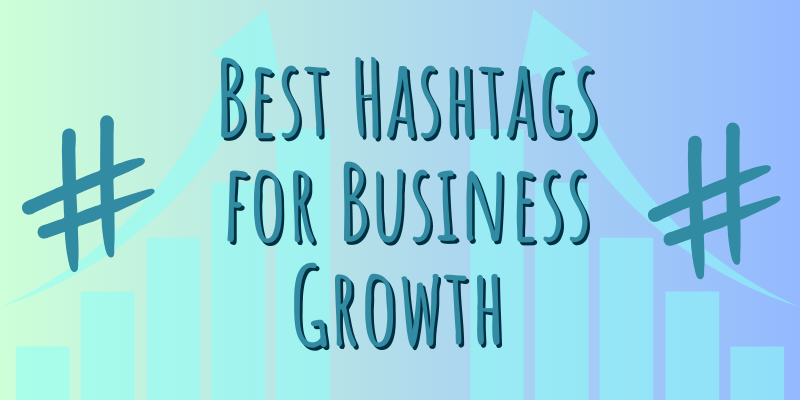
Best Hashtags for Business Growth: A Strategic Guide
In the vast realm of social media, where millions of posts flood the platforms every second, hashtags serve as guiding stars, leading you to the right audience, helping you expand your reach, and helping your potential customers find you. If you’re a solopreneur or a small business owner, understanding the art of using hashtags strategically, can significantly help in your growth journey.
In this comprehensive guide, we’ll explore the power of hashtags through these key points:
- Discover the best generic business growth hashtags (with list)
- Understand how strategic hashtags can drive algorithms and your growth
- Find niche-specific hashtags with the right tools
- Master hashtag best practices for top social media platforms
- Learn the common hashtag mistakes to avoid
- Embrace consistency in hashtag usage for brand building
- Plus 3 practical examples of hashtag strategy for a product, service and author business
Generic *Business Growth* Hashtags
As important to using hashtags to promote your business, is using hashtags to keep yourself inside the ecosystem of business growth on your favorite social media platform(s), generically. Use the best business growth hashtags to find and follow other business growth accounts so your feed keeps you in the loop and in this space. You’ll gain ideas and insights, motivations and inspirations. And when you also use these hashtags, you’re letting this business growth community know who you are, what you do, and that you’re also a part of this ecosystem.
If you haven’t searched your favorite social media platforms for these hashtags yet, and found some good, solid, helpful and inspiring accounts within this community… do it now!
Here are a few business growth hashtags to try:
- #BusinessGrowth
- #Entrepreneurship101
- #SolopreneurLife
- #SmallBizTips
- #StartupSuccess
Why is this important? Well, these hashtags serve as virtual meeting points for entrepreneurs and business-minded individuals. By exploring
posts under these hashtags, you can gain valuable insights, learn from others’
experiences, and even build meaningful connections within your niche. Here are three suggestions on how to use generic business growth hashtags effectively:
– Research and Bookmark: Regularly search for these hashtags (and/or similar trending ones) and bookmark and like posts that resonate with your business goals. Your goal would be to make sure your algorithm is feeding you helpful posts within this community so you can stay engaged with like-minded people.
– Engage and Network: Don’t just lurk; engage with posts, share your thoughts, and network with like-minded individuals. Ask questions, leave positive comments, like posts that you find helpful.
– Share Your Expertise: Contribute your knowledge, expertise, and challenges by posting relevant content under these hashtags.
Strategic *Business Growth* Hashtags
Now that you’ve dipped your toes into the world of business growth hashtags, let’s explore how strategic hashtag use can propel your business forward. The key lies in getting your content in front of the right people—your target audience. Here are the strategic steps to find the best hashtags for your specific niche:
Step 1: Understand Your Audience
- Define your target audience: Who are they? What are their interests, pain points, and preferences?
- Research competitors: Analyze the hashtags your competitors are using to reach their audience.
Step 2: Keyword Research
- Use keyword research tools like Google Keyword Planner or tools specific to social media like Hashtagify.
- Identify relevant keywords and phrases related to your business.
Step 3: Explore Hashtags
- Search for the keywords you’ve identified on social media platforms.
- Note the popularity and engagement levels of hashtags.
- Create a list of both broad and niche-specific hashtags.
Step 4: Test and Analyze
- Experiment with different combinations of hashtags in your posts.
- Monitor which hashtags generate the most engagement and traffic.
- Refine your hashtag strategy based on data.
Hashtag Best Practices for Popular Social Media Platforms
It’s important to note that while these are strategies to try… ultimately best hashtag practices aren’t set in stone. Each platform uses different algorithms, and has different ways their “search” works. This means it’s important to stay flexible and watch for trends and platform changes. Here are current strategic guidelines for the top social media platforms, for using hashtags to increase your exposure and grow your business.
When engaging with other business growth posts/accounts, you may want to use the trending or generic business growth hashtags. And when posting about your business, or to bring attention and exposure to your brand/business for growth purposes, consider using the same hashtags consistently of either your business name plus strategic niche, or trending hashtags within your niche to help your posts gain a stronger reach.
- Keep it concise: Use 1-2 relevant hashtags per post.
- Utilize trending or industry-specific hashtags.
- Join and engage in relevant Facebook groups using targeted hashtags.
- Aim for 2-3 hashtags per tweet.
- Utilize trending hashtags when applicable.
- Create branded hashtags for campaigns or promotions.
- Use 3-5 relevant hashtags in your LinkedIn posts.
- Follow and engage with industry-specific hashtags.
- Consider creating your own branded hashtags.
- Embrace the power of up to 30 hashtags per post.
- Combine popular, niche-specific, and branded hashtags.
- Engage with posts under relevant hashtags to boost visibility.
- Consider adding your 30 hashtags as the first comment to your post
- Add 2-5 relevant hashtags in your pin descriptions.
- Use keyword-rich descriptions to complement hashtags.
- Follow and engage with users who use similar hashtags.
- Use pins to drive direct traffic to your business website or a landing page.
Hashtag Mistakes to Avoid
- Overloading: Don’t stuff your posts with too many hashtags; it can look spammy.
- Irrelevant Tags: Ensure your hashtags are directly related to your content.
- Using Only Popular Tags: Balance popular and niche-specific hashtags for better targeting.
Consistency Is Key
As you build your brand and business, remember that consistency is essential for long-term growth. Create a set of hashtags that represent your brand identity and use them consistently across all your social media channels. And when possible, remember to add your brand hashtags to your social media profiles.
A Practical "Product" Business Example
"Best Handmade Soap Company"
Imagine you’ve just started a business, “Best HandMade Soap Company.” To harness the power of hashtags, you’d:
- Research hashtags related to handmade soaps:
#HandmadeSoap #NaturalSkincare #ArtisanSoap - Share your soap-making journey under these hashtags.
- Engage with fellow soap enthusiasts and potential customers.
- Create a branded hashtag like #BestHandmadeSoapCompany or #BestHandmadeSoapJourney to track your brand’s growth.
A Practical "Service" Business Example
"Jane Doe, Real Estate Agent"
Imagine you’re a top-notch real estate agent, “Jane Doe, Real Estate Agent.” Here’s how you can leverage hashtags for your business growth:
- Research hashtags related to your real estate market, farm area or specific niche:
#GreenHillsRealEstateExpert #FreeHomeBuyersGuide #GreenHillsRealtor #BestGreenHillsRealtor - Share stunning property listings under these hashtags to attract potential buyers
- Engage with clients’ success stories using your services and encourage them to use #JaneDoeRealtor
- Stay updated with local real estate trends by following area-specific hashtags like #GreenHillsHousingMarket #GreenHillsHomesforSale
- Create a branded hashtag such as #JaneDoeRealtor to use consistently in all your social media and profiles, to help track, search and showcase your success stories.
A Practical "Author" Business Example
John Smith, Author
As an aspiring author, “John Smith,” you can use hashtags to boost your exposure within the book community:
- Research hashtags for the book community (start with Instagram a.k.a. “bookstagram”):
#WritingCommunity #AuthorLife #BookLovers - Research most popular hashtags for your specific genre:
#fantasyfiction #smalltownromance #murdermystery - Share your writing journey, book updates, and writing tips under these popular author-related hashtags
- Engage with fellow writers, readers, and book enthusiasts to grow your network.
- Create a branded hashtag like #JohnSmithBooks or #JohnSmithAuthor to promote your published works (be consistent once you pick one!)
- Participate in trending book-related challenges or discussions to increase your visibility or offer to be interviewed for a podcast and use your hashtag to comment and share.
Conclusion
Hashtags are more than just trendy symbols; they’re potent tools for business growth in the digital age. Each social media platform uses different ways to search and filter posts and accounts through proprietary algorithms. These algorithms change periodically, and differ quite a bit from one platform to another, so it’s important to watch for trends and changes and stay up to date. By strategically using hashtags on various social media platforms, you can expand your reach, connect with your target audience, and ultimately boost your business’s growth potential.
And remember to adapt and refine your hashtag strategy as your business grows and evolves!
FAQ
How many hashtags should I use per post?
A: The ideal number varies by platform. Instagram allows up to 30, while Twitter is best with 2-3. For platforms like Facebook and LinkedIn, 1-5 hashtags are typically sufficient.
Q: Can I use the same hashtags on all social media platforms?
A: While you can use your brand hashtag when possible, plus some common hashtags across platforms, it’s essential to tailor your hashtag strategy to each platform’s audience and content format.
Q: How often should I update my list of hashtags?
A: Regularly review and update your hashtag list based on changing trends, audience preferences, and the performance of your posts. This ensures your strategy stays effective.
Q4: Should I create my own branded hashtags?
A: Yes, creating branded hashtags can help build your brand identity and engage your audience in a unique way. Just ensure they are relevant and memorable.
